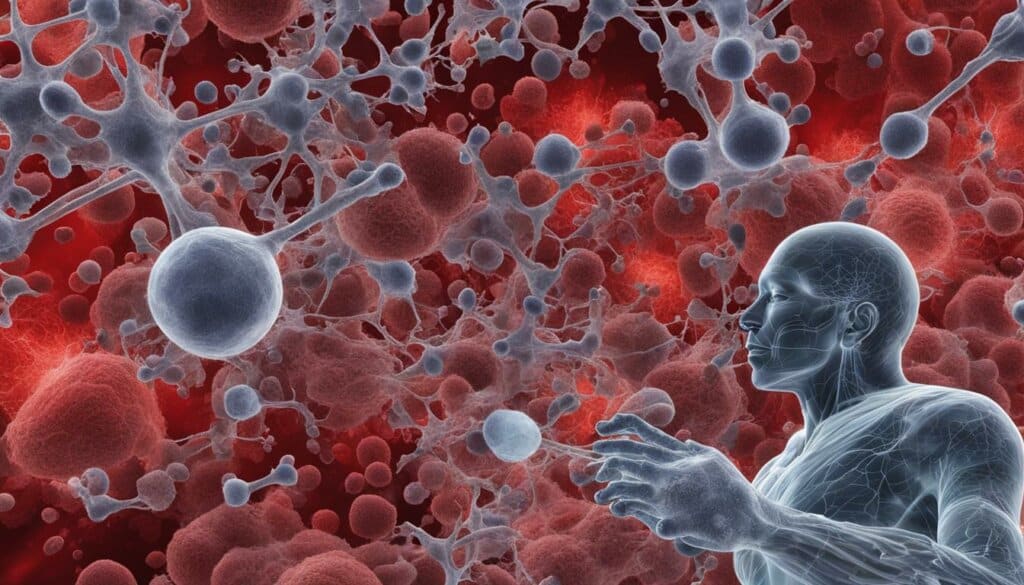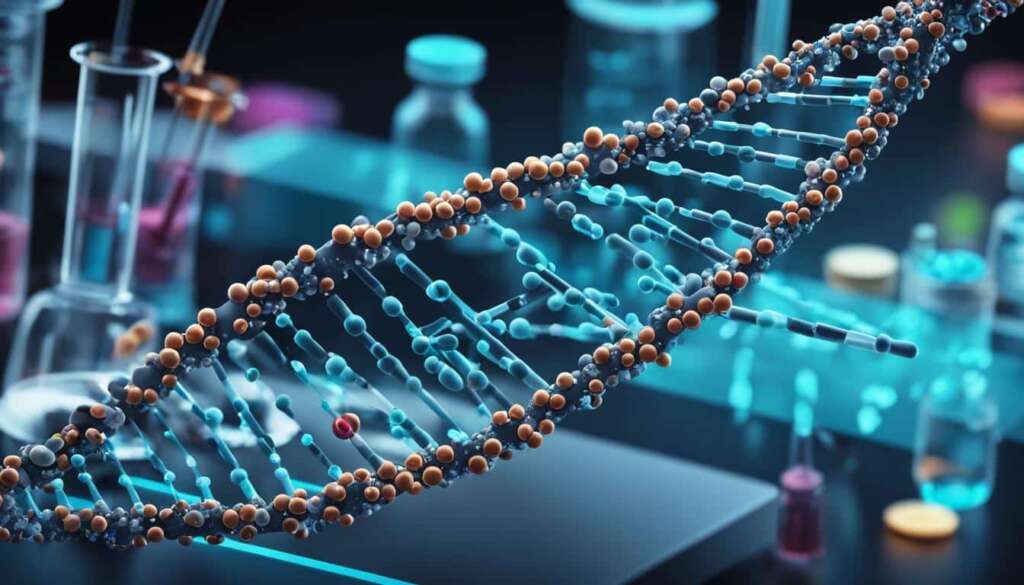Table of Contents
Nanotechnology is a cutting-edge science and engineering field that focuses on the manipulation of atoms and molecules at the nanoscale. It involves designing, producing, and using structures, devices, and systems that have dimensions of approximately 100 nanometres or less. At this scale, materials and structures exhibit unique properties and behaviours, leading to potential breakthroughs in various industries.
Key Takeaways
- Nanotechnology is a branch of science and engineering that manipulates atoms and molecules at the nanoscale.
- It involves working with structures, devices, and systems with dimensions of approximately 100 nanometres or less.
- Nanoscale materials and structures have unique properties and behaviours that can be harnessed for advancements in different industries.
- Nanotechnology has applications in fields such as information and communications, food technology, energy technology, and medicine.
- Understanding nanotechnology is essential for unlocking its potential and addressing its impact on society.
What is Nanotechnology?
Nanotechnology involves working with structures, devices, and systems that have one or more dimensions at the nanoscale. The nanoscale refers to dimensions of approximately 100 nanometers or less. At this scale, materials and structures exhibit unique properties and behaviors due to the high surface to volume ratio and quantum effects. Nanotechnology allows researchers to intentionally manipulate atoms and molecules to create new materials and devices with desired properties. This field has opened up new possibilities for various applications in different industries.
“Nanotechnology allows us to explore and manipulate the building blocks of the universe at an incredibly small scale, opening doors to countless technological breakthroughs.” – Dr. Jennifer Patel, Nanotechnology Research Scientist
Applications of Nanotechnology
Nanotechnology, with its capabilities to manipulate materials at the nanoscale, has found applications in various sectors, including information and communications, food technology, energy technology, and medicine. Its impact on society is profound as it enables the creation of new materials with unique properties and effects that cannot be observed at larger scales.
One of the key advantages of nanotechnology is its ability to design and produce new materials. These materials offer a wide range of benefits, such as improved performance, increased strength and durability, enhanced electrical and thermal conductivity, and reduced environmental pollution. To further illustrate the significance of nanotechnology applications, let’s explore some specific fields:
Electronics and Optoelectronics
Nanotechnology has revolutionized the electronics industry by enabling the miniaturization of electronic components. Nanoscale materials and devices have enhanced electrical conductivity and improved performance, leading to the development of smaller, more efficient electronic devices. Furthermore, nanotechnology has paved the way for optoelectronics, where light-emitting diodes (LEDs) and solar cells benefit from the unique properties of nanomaterials to achieve higher efficiency and functionality.
Catalysis and Pharmaceuticals
In the field of catalysis, nanomaterials have proven to be highly effective catalysts due to their large surface area and unique surface properties. These catalysts significantly improve the efficiency of chemical reactions and have applications in various industries, including petroleum refining and pharmaceutical synthesis. Nanotechnology also plays a crucial role in the development of targeted drug delivery systems, enabling precise and controlled release of medications to specific areas of the body.
Cosmetics and Coatings
Nanotechnology is reshaping the cosmetics and coatings industries by introducing innovative products with enhanced properties. Nanoscale compounds and particles can offer improved UV protection, better texture, and increased stability in cosmetic products. In the coatings industry, nanomaterials provide enhanced durability, scratch resistance, and self-cleaning properties. This not only improves the longevity of coatings but also reduces maintenance costs and environmental impact.
Medical Technology
Nanotechnology has transformative potential in the field of medicine. Nanoscale materials and devices enable precise diagnostics, targeted drug delivery, and regenerative medicine applications. For instance, nanoparticles can be engineered to detect and bind to specific cancer cells, allowing for early diagnosis and targeted therapy. Nanomaterials can also be used to create scaffolds for tissue engineering, promoting the regeneration of damaged tissues and organs.
This is just a glimpse of the wide range of applications that nanotechnology offers. Its impact on society spans across industries, improving products and processes, and paving the way for technological advancements. The ongoing research and development in nanotechnology hold promise for even more innovative applications that will continue to shape our future.
| Industry | Applications |
|---|---|
| Information and Communications | Miniaturized electronic components, high-density data storage |
| Food Technology | Improved food packaging, enhanced nutrient delivery |
| Energy Technology | Efficient energy production, advanced battery technology |
| Medicine | Precise diagnostics, targeted drug delivery, regenerative medicine |
Health Risks of Nanotechnology
While nanotechnology offers numerous benefits, there are also potential health risks associated with exposure to nanoparticles. The human body has developed defence mechanisms to protect against environmental agents of different sizes. However, these mechanisms may not be able to adequately respond to synthetic nanoparticles, as they have never been encountered before. Nanoparticles can bypass normal defence mechanisms and interact with the immune and inflammatory systems in unique ways. Additionally, nanoparticles may disperse and persist in the environment, posing potential risks to both human health and the ecosystem. It is important to thoroughly analyze the nature of these risks and develop appropriate risk management strategies to ensure the safe implementation of nanotechnology.
Exposure to nanoparticles presents various health risks that need to be carefully understood and managed. Let’s take a closer look at the potential dangers and defence mechanisms involved.
Health Risks of Nanotechnology
Nanoparticles are tiny particles with dimensions at the nanoscale, typically less than 100 nanometers in size. At this scale, the properties of materials can differ significantly from their bulk counterparts. While these unique properties have led to groundbreaking advancements in various fields, they also raise concerns regarding their impact on health.
When nanoparticles are inhaled or come into contact with the skin, they can enter the body and potentially cause harm. The human body has evolved defence mechanisms to protect against harmful substances, including the respiratory and immune systems. However, nanoparticles pose a challenge to these defence mechanisms due to their small size and distinctive physicochemical properties.
Defence Mechanisms and Nanoparticle Interactions
The respiratory system serves as the primary barrier against inhaled nanoparticles. Nasal hairs and mucus in the nasal passages trap larger particles, preventing them from reaching the delicate tissues of the lungs. In the lungs, the airways are lined with specialized cells called macrophages, which engulf and neutralize foreign particles.
However, nanoparticles can bypass these defence mechanisms due to their small size. They can reach deep into the lungs and interact directly with lung tissues and cells, potentially leading to inflammation, oxidative stress, and other adverse effects. Additionally, nanoparticles in contact with the skin can penetrate the skin barrier and enter the bloodstream, where they can potentially reach various organs and tissues.
Evaluating and Managing Health Risks
Understanding the health risks of nanotechnology is crucial for ensuring the safe development and application of nanomaterials. Researchers and regulatory bodies employ various methods to assess the potential hazards associated with nanoparticles, including laboratory studies, animal models, and epidemiological data.
When evaluating health risks, factors such as nanoparticle size, shape, surface properties, and chemical composition are taken into account. These characteristics can influence the toxicity and biological interactions of nanoparticles within the body. By studying these factors, researchers can develop guidelines and regulations to protect public health and guide the responsible use of nanotechnology.
Safe Implementation of Nanotechnology
Risk management strategies are essential for ensuring the safe implementation of nanotechnology. These strategies involve assessing the potential risks, implementing preventive measures, and establishing appropriate regulations.
To protect individuals involved in nanotechnology research, manufacturing, and use, it is crucial to implement engineering controls, such as enclosure systems and ventilation, to minimize the release and exposure to nanoparticles in the workplace. Personal protective equipment, including masks, gloves, and protective clothing, may also be necessary for individuals at risk of exposure.
Furthermore, environmental monitoring and containment measures are vital to prevent the release of nanoparticles into the environment, minimizing their potential impact on ecosystems and human populations.
By proactively addressing the health risks associated with nanotechnology, we can unlock its full potential while ensuring the well-being of individuals and the environment.
| Health Risks | Defence Mechanisms | Risk Management Strategies |
|---|---|---|
| Nanoparticles can bypass normal defence mechanisms and interact with the immune and inflammatory systems in unique ways. | The respiratory system and immune system are the body’s primary defence mechanisms. | Implement engineering controls, personal protective equipment, and environmental monitoring to minimize exposure and prevent the release of nanoparticles. |
| Nanoparticles may disperse and persist in the environment, posing potential risks to both human health and the ecosystem. | Nasal hairs, mucus, and macrophages play a role in defending against foreign particles. | Thoroughly analyze the nature of health risks and develop appropriate risk management strategies. |
Exposure to nanoparticles requires a comprehensive understanding of the associated risks and the implementation of effective risk management strategies. By addressing these challenges, we can harness the power of nanotechnology while safeguarding human health and the environment.

Types of Nanomaterials
Nanomaterials can be classified into different categories based on their origin and structure. There are two main types of nanomaterials: natural nanomaterials and artificial nanomaterials.
Natural Nanomaterials
Natural nanomaterials are materials that occur naturally in the world. They have nanoscale dimensions and exhibit unique properties. Examples of natural nanomaterials include:
- Volcanic ash
- Smoke particles
- Certain molecules in our bodies
These natural nanomaterials play a crucial role in various natural processes and have been studied for their potential applications in fields such as medicine, environmental science, and energy.
Artificial Nanomaterials
Artificial nanomaterials, as the name suggests, are intentionally produced by humans for various purposes. They are designed and synthesized to have specific properties and applications. Examples of artificial nanomaterials include:
- Nanoparticles made of different elements like gold, silicon, and titanium
- Carbon-based nanomaterials like fullerenes and nanotubes
Artificial nanomaterials are extensively used in industries such as electronics, medicine, and materials science due to their unique properties at the nanoscale.
To summarize, nanomaterials can be classified into natural nanomaterials and artificial nanomaterials. While natural nanomaterials occur naturally in the world, artificial nanomaterials are intentionally produced by humans. Both types of nanomaterials have different properties and applications in various industries.
Fullerenes and Nanoparticles
Fullerenes are allotropes of carbon that form atom-thick sheets rolled into spheres or tubes. The most well-known fullerene is the buckminsterfullerene, which has a cage-like structure made up of tightly bonded hexagons and pentagons. Buckyballs are highly stable and can exist even in extreme environments like outer space.
Nanoparticles, on the other hand, are particles with one or more dimensions at the nanoscale. They can include carbon as well as nanometer-scale versions of other elements. Nanoparticles have unique properties and behaviors due to their small size and high surface to volume ratio.
Both fullerenes and nanoparticles have various applications in fields such as electronics, medicine, and environmental science.
Nanoparticles in Electronics:
Nanoparticles play a crucial role in the field of electronics, where their unique properties are harnessed to enhance device performance. For example, the use of semiconductor nanoparticles can improve the efficiency and stability of solar cells. Additionally, magnetic nanoparticles find applications in data storage and magnetic resonance imaging (MRI) technology. The ability to manipulate nanoparticles at the nanoscale allows for the creation of smaller and more efficient electronic devices.
Nanoparticles in Medicine:
The medical field benefits greatly from the unique properties of nanoparticles. They can be used for targeted drug delivery, where nanoparticles can be designed to release medication at specific sites within the body. This approach reduces side effects and improves the efficacy of treatments. Furthermore, nanoparticles are useful in medical imaging techniques, such as nanoparticle-based contrast agents for MRI scans. Nanoparticles also show promise as carriers for gene therapy and as diagnostic tools for detecting diseases.
Nanoparticles in Environmental Science:
Nanoparticles have applications in environmental science for pollution remediation and water purification. For example, certain nanoparticles can be used to remove toxins and heavy metals from contaminated soil or water. Nanoparticles are also employed in catalysis, where they enhance chemical reactions to convert harmful pollutants into less harmful substances. The unique properties of nanoparticles make them valuable tools in addressing environmental challenges and promoting sustainable practices.
| Nanoscale Material | Properties | Applications |
|---|---|---|
| Fullerenes | High stability; unique cage-like structure |
|
| Nanoparticles | Small size; high surface to volume ratio |
|

Intentionally Produced Nanomaterials
Intentionally produced nanomaterials play a crucial role in the field of nanotechnology, offering unique properties and diverse applications. These materials are specifically synthesized or fabricated using precise methods to control their structures and properties. Let’s explore some of the key categories of intentionally produced nanomaterials:
Carbon-based Nanomaterials
One category of intentionally produced nanomaterials is carbon-based materials. These include remarkable structures such as carbon nanotubes and buckyballs. Carbon nanotubes are cylindrical structures made of carbon atoms arranged in a hexagonal lattice. They possess exceptional strength, high thermal conductivity, and unique electrical properties. Buckyballs, also known as fullerenes, consist of carbon atoms arranged in a spherical lattice. Their fascinating structure and properties make them suitable for various applications in electronics, energy, and nanomedicine.
Metal-based Nanomaterials
Another category of intentionally produced nanomaterials comprises metal-based materials. Gold nanoparticles and quantum dots are noteworthy examples in this category. Gold nanoparticles, at the nanoscale, demonstrate extraordinary optical and catalytic properties. They find applications in fields such as sensing, drug delivery, and electronics. Quantum dots are semiconducting nanocrystals that exhibit unique size-dependent properties, making them attractive for use in fields like imaging, solar cells, and quantum computing.
Dendrimers
Dendrimers are complex nanoparticles formed from linked, branched units. They possess well-defined structures with a high degree of symmetry. Dendrimers can perform specific chemical functions due to their precise design and defined surface functionalities. These unique properties make dendrimers valuable in applications such as drug delivery, imaging, and sensor development. They offer immense potential in targeted therapeutics and nanomedicine.
Nanocomposites
Nanocomposites are hybrid structures that combine nanomaterials with other materials. By incorporating nanoscale materials into a matrix or bulk material, nanocomposites exhibit enhanced properties compared to their pure counterparts. The addition of nanomaterials can improve mechanical strength, electrical conductivity, thermal stability, and barrier properties. Nanocomposites find applications in various industries, including aerospace, automotive, construction, and electronics.
With their diverse characteristics and applications, intentionally produced nanomaterials provide a foundation for advancements in fields such as manufacturing, electronics, energy, and medicine. The ability to control the structures and properties of these nanomaterials opens up a world of possibilities for innovation and development.
- “Carbon nanotubes: present and future commercial applications.” https://iopscience.iop.org/article/10.1088/0957-4484/21/29/292001
- “Gold nanoparticles: interesting optical properties and recent applications in cancer diagnostics and therapy.” https://www.ncbi.nlm.nih.gov/pmc/articles/PMC2697633/
- “Quantum dots: synthesis, properties, and applications.” https://pubs.acs.org/doi/10.1021/cm9600257
- “Dendrimers as Drug Carriers: Applications in Different Routes of Drug Administration.” https://www.ncbi.nlm.nih.gov/pmc/articles/PMC4851270/
- “Nanocomposites: synthesis, structure, properties and new application opportunities.” https://royalsocietypublishing.org/doi/10.1098/rsta.2008.0069
Nanomanufacturing and Nanotechnology Equipment
Nanotechnology, a field that involves working with structures and materials at the nanoscale, requires specialized equipment for research and manufacturing purposes. Nanomanufacturing, the process of building materials and products on the nanoscale, utilizes various techniques, including top-down and bottom-up methods.
In top-down methods, bulk materials are carved or manipulated to create nanoscale features. This approach involves reducing the size of larger materials to achieve the desired nanoscale dimensions. On the other hand, bottom-up methods involve building materials and products atom-by-atom or molecule-by-molecule, allowing for precise control over the final structure.
Within the field of nanotechnology, researchers rely on advanced tools to manipulate and study individual atoms and molecules. Two such tools are the atomic force microscope (AFM) and the scanning tunneling microscope (STM).

The atomic force microscope (AFM) is an imaging technique that utilizes a sharp probe to scan a sample surface. By measuring the forces between the probe and the sample, the AFM can generate high-resolution images at the nanoscale. This tool is widely used for characterizing the surface topography and mechanical properties of nanoscale materials.
The scanning tunneling microscope (STM) is another powerful imaging and manipulation tool used in nanotechnology. It operates by scanning a conducting probe over the surface of a sample, measuring the tunneling current that flows between the probe and the sample. The STM provides atomic-scale resolution and is essential for studying the electronic properties and manipulating individual atoms and molecules.
These advanced tools, such as the AFM and the STM, allow scientists to visualize and manipulate structures at the nanoscale. With their help, researchers can create and analyze nanoscale materials and devices, leading to breakthroughs in various fields, including electronics, medicine, and materials science.
Definitions and Scope of Nanotechnology
Nanotechnology is a field of study that encompasses the design, characterization, production, and application of structures, devices, and systems by controlling their shape and size at the nanoscale. The nanoscale refers to dimensions up to 100 nanometers, where materials exhibit unique properties and behaviors. Nanoscience, on the other hand, involves the study of phenomena and the manipulation of materials at atomic, molecular, and macromolecular scales. It is an interdisciplinary field that integrates principles from physics, chemistry, biology, and engineering to explore and understand the nanoscale world.
In nanotechnology, scientists and engineers work with materials and phenomena at the nanoscale to create novel functionalities and properties. While precise measurements of nanoscale parameters may have inherent inconsistencies and inaccuracies, the general understanding remains consistent—nanotechnology deals with structures and systems that operate at dimensions within the nanoscale range.
Nanotechnology has the potential to revolutionize various industries by offering unprecedented control over matter and the ability to create materials, devices, and systems with enhanced performance and functionality. This technology has applications in electronics, medicine, energy, environmental science, and many other fields.
“Nanotechnology allows us to manipulate and engineer materials at the atomic and molecular level, opening up a world of possibilities for innovation and progress.” – Dr. Emma Johnson, Nanotechnology Researcher
Nanoscale Range
The nanoscale range refers to dimensions up to 100 nanometers. At this scale, matter exhibits unique properties and behaviors due to the high surface-to-volume ratio and quantum effects. It is important to note that nanoscale dimensions can vary depending on the context and specific scientific discipline. However, the general consensus is that the nanoscale encompasses dimensions within the range mentioned above.
| Scale | Dimensions |
|---|---|
| Nanoscale | Up to 100 nanometers |
| Micronscale | 1 micrometer (1,000 nanometers) to 1,000 micrometers |
| Millimeter scale | 1,000 micrometers to 1,000 millimeters |
| Meter scale | 1,000 millimeters and beyond |
The nanoscale range is particularly significant in nanotechnology because materials and systems at this scale can exhibit properties and behaviors distinct from their bulk counterparts. This allows scientists and engineers to unlock new functionalities and tailor materials to specific requirements, leading to groundbreaking innovations.
Nanoscience
Nanoscience is the study of phenomena and manipulation of materials at atomic, molecular, and macromolecular scales. It focuses on understanding and harnessing the unique properties and behaviors of matter at the nanoscale. Nanoscience is essential for the advancement of nanotechnology as it provides the fundamental knowledge and insights required to design and engineer nanoscale structures, devices, and systems.
Nanoscience encompasses various scientific disciplines, including physics, chemistry, biology, and engineering. Researchers in these fields collaborate to explore the fundamental principles governing nanoscale phenomena and to develop innovative techniques for manipulating and characterizing nanoscale materials.
“Nanoscience is like a window into a whole new world, where atoms and molecules dance to their own tune, shaping the future of technology and discovery.” – Dr. Sarah Wilson, Nanoscientist
Through nanoscience, scientists aim to unravel the complexities of the nanoscale world and harness its immense potential for technological advancements. By studying and manipulating materials at atomic and molecular levels, researchers pave the way for groundbreaking discoveries and the development of future technologies.
Risks and Regulation of Nanotechnology
Nanotechnology holds great promise for various industries, but it also presents unique risks that need to be carefully analyzed and managed. The properties of nanoscale materials and nanoparticles can give rise to potential health concerns, requiring comprehensive risk analysis and appropriate risk management strategies.
Recognizing the importance of addressing these risks, numerous international organizations, governmental bodies, and research institutions have emphasized the need for regulations to ensure the safe and responsible use of nanotechnology. Governments and regulatory bodies are actively working towards establishing frameworks and guidelines that promote the safe, sustainable, and socially acceptable application of nanotechnologies.
During the life cycle of nanotechnology-based products, it is crucial to consider and address potential risks related to health, environment, and society. This comprehensive approach to risk management will help mitigate any potential negative impacts and enable the safe integration of nanotechnology into our daily lives.
Conclusion
Nanotechnology is a rapidly advancing field that involves manipulating atoms and molecules at the nanoscale. With its wide-ranging applications, nanotechnology has the potential to revolutionize industries such as electronics, medicine, energy, and environmental science. However, it is crucial to carefully consider the unique properties and potential health risks associated with nanoscale materials and nanoparticles.
Ensuring the safe and responsible use of nanotechnology requires thorough risk assessment and management strategies. Governments, international organizations, and research institutions are actively working towards establishing regulations and guidelines to mitigate potential risks. By prioritizing safety, sustainability, and ethical considerations, we can unlock the full potential of this cutting-edge science.
In conclusion, nanotechnology offers a myriad of benefits, but it is essential to approach its development and implementation with caution. Through rigorous analysis and responsible regulation, we can harness the power of nanotechnology to shape a better future for various industries and society as a whole.
FAQ
What is nanotechnology?
Nanotechnology refers to the branch of science and engineering that focuses on designing, producing, and using structures, devices, and systems by manipulating atoms and molecules at the nanoscale.
What does the term nanoscale mean?
The nanoscale refers to dimensions of approximately 100 nanometers (100 millionth of a millimeter) or less. At this scale, materials and structures exhibit unique properties and behaviors due to the high surface to volume ratio and quantum effects.
What are the applications of nanotechnology?
Nanotechnology has applications in various industries, including information and communications, food technology, energy technology, and medicine. It allows for the creation of new materials with unique properties, offering benefits such as improved performance, increased strength and durability, enhanced electrical and thermal conductivity, and reduced environmental pollution.
Are there any health risks associated with nanotechnology?
Yes, there are potential health risks associated with exposure to nanoparticles. Nanoparticles can bypass normal defence mechanisms in the human body and interact with the immune and inflammatory systems in unique ways. They may also disperse and persist in the environment, posing risks to human health and the ecosystem.
What are the types of nanomaterials?
Nanomaterials can be classified into different categories based on their origin and structure. Natural nanomaterials occur naturally in the world, while artificial nanomaterials are intentionally produced by humans. Examples of artificial nanomaterials include nanoparticles made of different elements like gold, silicon, and titanium, as well as carbon-based nanomaterials like fullerenes and nanotubes.
What are fullerenes and nanoparticles?
Fullerenes are allotropes of carbon that form atom-thick sheets rolled into spheres or tubes, with the most well-known fullerene being the buckminsterfullerene. Nanoparticles, on the other hand, are particles with one or more dimensions at the nanoscale. Both fullerenes and nanoparticles have various applications in fields such as electronics, medicine, and environmental science.
What are intentionally produced nanomaterials?
Intentionally produced nanomaterials include carbon-based materials like carbon nanotubes and buckyballs, as well as metal-based materials like gold nanoparticles and quantum dots. These materials are synthesized or fabricated using specific methods to control their structures and properties.
What is nanomanufacturing and what equipment is used in nanotechnology?
Nanomanufacturing involves building materials and products on the nanoscale, either through top-down or bottom-up methods. Researchers use advanced tools such as the atomic force microscope (AFM) and the scanning tunneling microscope (STM) to manipulate and study individual atoms and molecules, allowing them to create and analyze nanoscale materials and devices.
What is the scope of nanotechnology?
Nanotechnology is defined as the design, characterization, production, and application of structures, devices, and systems by controlling shape and size at the nanoscale. Nanoscience, on the other hand, is the study of phenomena and manipulation of materials at atomic, molecular, and macromolecular scales.
What risks and regulations are associated with nanotechnology?
The unique properties and potential health risks associated with nanotechnology require careful analysis and regulation. Governments and regulatory bodies are working towards establishing frameworks and guidelines to ensure the safe, sustainable, and socially acceptable application of nanotechnologies. Risk analysis and management strategies are essential to address any health, environmental, and societal concerns.













